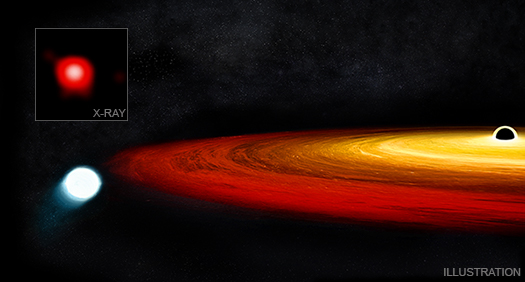For Release: April 23, 2020
NASA/CXC

X-ray: NASA/CXO/CSIC-INTA/G.Miniutti et al.; Illustration: NASA/CXC/M. Weiss;
Press Image, Caption, and Videos
Astronomers may have discovered a new kind of survival story: a star that had a brush with a giant black hole and lived to tell the tale through exclamations of X-rays.
Data from NASA's Chandra X-ray Observatory and ESA's XMM-Newton uncovered the account that began with a red giant star wandering too close to a supermassive black hole in a galaxy about 250 million light years from Earth. The black hole, located in a galaxy called GSN 069, has a mass about 400,000 times that of the Sun, putting it on the small end of the scale for supermassive black holes.
Once the red giant was captured by the black hole's gravity, the outer layers of the star containing hydrogen were stripped off and careened toward the black hole, leaving the core of the star — known as a white dwarf — behind.
"In my interpretation of the X-ray data the white dwarf survived, but it did not escape," said Andrew King of the University of Leicester in the UK, who performed this study. "It is now caught in an elliptical orbit around the black hole, making one trip around about once every nine hours."
As the white dwarf makes its nearly thrice-daily orbit, the black hole pulls material off at its closest approach (no more than 15 times the radius of the event horizon — the point of no return — away from the black hole). The stellar detritus enters into a disk surrounding the black hole and releases a burst of X-rays that Chandra and XMM-Newton can detect. In addition, King predicts gravitational waves will be emitted by the black hole and white dwarf pair, especially at their nearest point.
What would be the future of the star and its orbit? The combined effect of gravitational waves and a change in the star's size as it loses mass should cause the orbit to become more circular and grow in size. The rate of mass loss steadily slows down, as does the increase in the white dwarf's distance from the black hole.
"It will try hard to get away, but there is no escape. The black hole will eat it more and more slowly, but never stop," said King. "In principle, this loss of mass would continue until and even after the white dwarf dwindled down to the mass of Jupiter, in about a trillion years. This would be a remarkably slow and convoluted way for the universe to make a planet!"
Astronomers have found many stars that have been completely torn apart by encounters with black holes (so-called tidal disruption events), but there are very few reported cases of near misses, where the star likely survived.
Grazing encounters like this should be more common than direct collisions given the statistics of cosmic traffic patterns, but they could easily be missed for a couple of reasons. First, it can take a more massive, surviving star too long to complete an orbit around a black hole for astronomers to see repeated bursts. Another issue is that supermassive black holes that are much more massive than the one in GSN 069 may directly swallow a star rather than the star falling into orbits where they periodically lose mass. In these cases, astronomers wouldn't observe anything.
"In astronomical terms, this event is only visible to our current telescopes for a short time — about 2,000 years," said King. "So unless we were extraordinarily lucky to have caught this one, there may be many more that we are missing. Such encounters could be one of the main ways for black holes the size of the one in GSN 069 to grow."
King predicts that the white dwarf has a mass of only two tenths the mass of the Sun. If the white dwarf was the core of the red giant that was completely stripped of its hydrogen, then it should be rich in helium. The helium would have been created by the fusion of hydrogen atoms during the evolution of the red giant.
"It's remarkable to think that the orbit, mass and composition of a tiny star 250 million light years away could be inferred," said King.
King made a prediction based on his scenario. Because the white dwarf is so close to the black hole, effects from the Theory of General Relativity mean that the direction of the orbit's axis should wobble, or "precess." This wobble should repeat every two days and may be detectable with sufficiently long observations.
A paper describing these results appears in the March 2020 issue of the Monthly Notices of the Royal Astronomical Society, and is available online. NASA's Marshall Space Flight Center manages the Chandra program. The Smithsonian Astrophysical Observatory's Chandra X-ray Center controls science and flight operations from Cambridge and Burlington, Massachusetts.
Other materials about the findings are available at:
http://chandra.si.edu
For more Chandra images, multimedia and related materials, visit:
http://www.nasa.gov/chandra
Media contacts:
Molly Porter
NASA Marshall Space Flight Center, Huntsville, Ala.
256-424-5158
molly.a.porter@nasa.gov
Megan Watzke
Chandra X-ray Center, Cambridge, Mass.
617-496-7998
mwatzke@cfa.harvard.edu


